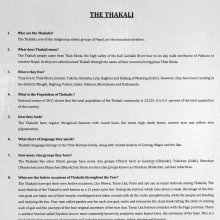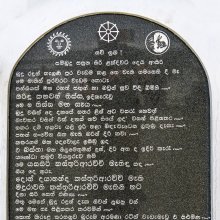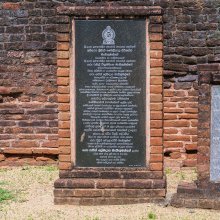Saya, Sāya, Sāyā, Śaya, Śāya, Shaya: 20 definitions
Introduction:
Saya means something in Buddhism, Pali, Hinduism, Sanskrit, the history of ancient India, Marathi, Jainism, Prakrit, Hindi. If you want to know the exact meaning, history, etymology or English translation of this term then check out the descriptions on this page. Add your comment or reference to a book if you want to contribute to this summary article.
The Sanskrit terms Śaya and Śāya can be transliterated into English as Saya or Shaya, using the IAST transliteration scheme (?).
Images (photo gallery)
In Hinduism
Purana and Itihasa (epic history)
Source: Cologne Digital Sanskrit Dictionaries: The Purana Index1) Sāya (साय).—A son of Prabhā.*
- * Bhāgavata-purāṇa IV. 13. 13.
2) Sāyā (साया).—(Evening); born of Dhātrī and Kuhū*
- * Bhāgavata-purāṇa VI. 18. 3; Brahmāṇḍa-purāṇa II. 21. 121.

The Purana (पुराण, purāṇas) refers to Sanskrit literature preserving ancient India’s vast cultural history, including historical legends, religious ceremonies, various arts and sciences. The eighteen mahapuranas total over 400,000 shlokas (metrical couplets) and date to at least several centuries BCE.
Kavya (poetry)
Source: archive.org: Naisadhacarita of SriharsaSāya (साय) is used as a noun for sāyam in sāyadhūrtaḥ, and is mentioned in the Naiṣadha-carita 22.52.

Kavya (काव्य, kavya) refers to Sanskrit poetry, a popular ancient Indian tradition of literature. There have been many Sanskrit poets over the ages, hailing from ancient India and beyond. This topic includes mahakavya, or ‘epic poetry’ and natya, or ‘dramatic poetry’.
Dharmashastra (religious law)
Source: Srimatham: History of DharmaśāstraSāya (साय) (or Astagamana or Sāyāhna) refers to “evening”.—The day (of 12 hours) was often divided into five parts, viz. prāta or udaya (sunrise), saṅgava, mādhyandina or madhyahna (mid-day), aparahna (afternoon) and sāyāhna or astagamana or sāya (evening). Each of these five parts of day time will be equal to three muhūrtas. In some smṛtis and Purānas these five parts are mentioned and defined; e.g. in the Prajāpati-smṛti, vv.156157, Matsya Purāṇa 22.82-84, 124.88-90, Vayu 50.170-174.

Dharmashastra (धर्मशास्त्र, dharmaśāstra) contains the instructions (shastra) regarding religious conduct of livelihood (dharma), ceremonies, jurisprudence (study of law) and more. It is categorized as smriti, an important and authoritative selection of books dealing with the Hindu lifestyle.
In Buddhism
Mahayana (major branch of Buddhism)
Source: Wisdom Library: Maha Prajnaparamita SastraŚaya (शय) refers to “beds”, according to Mahāprajñāpāramitāśāstra (chapter 4).—Accordingly, “[The Buddha] is single-minded (ekacitta), without duality (advaya). In all things, whatever they may be, food and drink (āhāra), robes and clothing (paṭa-vasana), beds and seats (śaya-āsana), praise and blame (varṇana-vijṛmbhā), mistrust and respect (vitaṇḍana-gaurava), the Buddha’s mind remains indifferent. It is like pure gold which, even when burned, melted, beaten or polished, shows no increase or decrease. [On the contrary], the Arhats, although they have broken the bonds (bandhana) and have found the Path, still retain the traces (vāsana) [of the passions]; this is why they cannot be called Bhagavat”.
Source: archive.org: Bulletin of the French School of the Far East (volume 5)Śaya (शय) (in Chinese: Chö-ye) refers to one of the fifty-five kingdoms enumerated in chapter 17 of the Candragarbha: the 55th section of the Mahāsaṃnipāta-sūtra, a large compilation of Sūtras (texts) in Mahāyāna Buddhism partly available in Sanskrit, Tibetan and Chinese.—In the Candragarbhasūtra, the Bhagavat invites all classes of Gods and Deities to protect the Law [dharma?] and the faithful in their respective districts.—In Śaya, the following deities are appointed (among others): The Devarṣi Maheśvara; the Gandharva Asura; the Kinnara Nirmala; the Yakṣas Indra and Soma; the Nāga Sudarśana; the Asurarāja Mucilinda; the Kumbhāṇḍas Upadanti and Kṛkaśa; the Goddesses Hāritī and Supālī.
Śaya (शय) (in Chinese: Chö-ye) is the name of an ancient kingdom associated with Kṛttikā or Kṛttikānakṣatra, as mentioned in chapter 18.

Mahayana (महायान, mahāyāna) is a major branch of Buddhism focusing on the path of a Bodhisattva (spiritual aspirants/ enlightened beings). Extant literature is vast and primarely composed in the Sanskrit language. There are many sūtras of which some of the earliest are the various Prajñāpāramitā sūtras.
India history and geography
Source: Cologne Digital Sanskrit Dictionaries: Indian Epigraphical GlossaryŚaya.—(IE 3-4), derived from a Chinese word; paper. Note: śaya is defined in the “Indian epigraphical glossary” as it can be found on ancient inscriptions commonly written in Sanskrit, Prakrit or Dravidian languages.

The history of India traces the identification of countries, villages, towns and other regions of India, as well as mythology, zoology, royal dynasties, rulers, tribes, local festivities and traditions and regional languages. Ancient India enjoyed religious freedom and encourages the path of Dharma, a concept common to Buddhism, Hinduism, and Jainism.
Languages of India and abroad
Pali-English dictionary
Source: Sutta: The Pali Text Society's Pali-English DictionarySāya, (cp. Sk. sāyaṃ, on which Aufrecht, Halāyudha p. 380, remarks: “this word seems to be the gerund of sā, and to have signified originally “having finished. ” A masc. sāya does not exist. ” Cp. Vedic °sāya) evening, only adverbially sāyaṃ, at night Vin. III, 147; J. II, 83; DhA. I, 234; usually opposed to pāto (pātaṃ) in the morning, early e.g. sāya-pātaṃ D. II, 188; Miln. 419; J. I, 432, 460; V, 462; sāyaṃ-pātaṃ Vin. II, 185; DhA. II, 66; sāyañ ca pāto ca Pv. I, 63; II, 937; PvA. 127; sāya-tatiyaka for the third time in the evening D. I, 167; A. II, 206; V, 263, 266, 268; M. I, 343; sāyamāsa supper J. I, 297; V, 461; DhA. I, 204. sāyaṃ as quâsi-nominative: sāyaṃ ahosi J. VI, 505; atisāyaṃ too late Th. 1, 231; J. II, 362; V, 94; sāyataraṃ later in the evening (compar.) J. VI, 366. (Page 705)
— or —
Saya, =saka (?) one’s own J. VI, 414 (=saka-raṭṭha C.). (Page 697)

Pali is the language of the Tipiṭaka, which is the sacred canon of Theravāda Buddhism and contains much of the Buddha’s speech. Closeley related to Sanskrit, both languages are used interchangeably between religions.
Marathi-English dictionary
Source: DDSA: The Molesworth Marathi and English Dictionarysaya (सय).—f (Or saī) Recollection, remembrance, memory of.
--- OR ---
saya (सय).—f (Esp. in poetry.) A female friend or companion, a confidante. Ex. sayē kaiṃ manōratha jagannātha puravī.
--- OR ---
sayā (सया).—m ( A) An individual of the sect of along. Muhammad's son-in-law. See sunī. sayā & sunī are words in common use for & the distinction betwixt these sects being forced upon the notice of the Hindus by the annual Muharram.
--- OR ---
sāya (साय).—m (śāka S) The teak-tree, Tectona grandis 2 Teak-wood.
--- OR ---
sāya (साय).—f (sāra S) Cream. Applied also to the rich and creamlike skimmings of sugarcane-juice under inspissation by boiling.
--- OR ---
sāyā (साया).—m (śāka S) The teak-tree, Tectona grandis. Pr. sāyā vṛkṣāñcā rāyā. 2 Teak-wood.
Source: DDSA: The Aryabhusan school dictionary, Marathi-Englishsaya (सय).—f Recollection. A female friend, a confidante.
--- OR ---
sāya (साय).—m The teak-tree; teak wood. f Cream.
Marathi is an Indo-European language having over 70 million native speakers people in (predominantly) Maharashtra India. Marathi, like many other Indo-Aryan languages, evolved from early forms of Prakrit, which itself is a subset of Sanskrit, one of the most ancient languages of the world.
Sanskrit dictionary
Source: DDSA: The practical Sanskrit-English dictionaryŚaya (शय).—a. (-yā, -yī f.) [शी-अच् (śī-ac)] Lying down, sleep ing (usually at the end of comp.); रात्रिजागरपरो दिवाशयः (rātrijāgaraparo divāśayaḥ) R.19.34; so उत्तानशय, पार्श्वशय, वृक्षेशय, विलेशय (uttānaśaya, pārśvaśaya, vṛkṣeśaya, vileśaya) &c.
-yaḥ 1 Sleep.
2) A bed, couch; मायाशये शयाना मे नाद्यापि पुन- रुत्थिताः (māyāśaye śayānā me nādyāpi puna- rutthitāḥ) Bhāgavata 1.13.41.
3) A hand; सुन्दरीभिः शयाम्भोज- संवाहितपदं पुनः (sundarībhiḥ śayāmbhoja- saṃvāhitapadaṃ punaḥ) Śiva B.2.91; तदूरुकाण्डे सविलासमर्पितः शयः शयानेन सहानयामुना (tadūrukāṇḍe savilāsamarpitaḥ śayaḥ śayānena sahānayāmunā) Rām. ch.2.49; also used as a measure of length.
4) A snake, especially the boa.
5) Abuse, imprecation, curse.
6) A stake.
--- OR ---
Śāya (शाय).—Lying, sleeping.
Derivable forms: śāyaḥ (शायः).
--- OR ---
Sāya (साय).—[so-ghañ]
1) End, close, termination.
2) Close of day, evening.
3) An arrow, a missile. (sāye 'in the evening, at the close of the day'.)
Derivable forms: sāyaḥ (सायः).
Source: Cologne Digital Sanskrit Dictionaries: Edgerton Buddhist Hybrid Sanskrit DictionaryŚaya (शय).—(or śayā), m.c. for (Sanskrit) śayyā, § 2.89, bed: śayāto, abl., Lalitavistara 230.11 (verse; śayyāto would be unmetrical(ly)).
--- OR ---
Śayā (शया).—(abl. śayāto), m.c. for śayyā, see śaya; śayāni, loc., m.c. for śayane, on the bed: tubhya prekṣami śayāni suptikāṃ Lalitavistara 236.3 (verse).
Source: Cologne Digital Sanskrit Dictionaries: Shabda-Sagara Sanskrit-English DictionaryŚaya (शय).—mfn.
(-yaḥ-yā or yī-yaṃ) Asleep, sleeping. m.
(-yaḥ) 1. A hand. 2. A snake, (Boa constrictor.) 3. Sleep, sleeping. 4. A bed, a couch. 5. Abuse, imprecation. E. śī to sleep, aff. gha, ṭac or ac .
--- OR ---
Śayā (शया) or Śayyā.—f.
(-yā) 1. A bed, a couch, a sopha. 2. Tying in knots, stringing. E. śī to sleep, kyap aff., and ayaṅ substituted for the vowel.
--- OR ---
Sāya (साय).—m.
(-yaḥ) 1. Evening, close of day. 2. An arrow. 3. End, termination. close in general. E. ṣo to end or destroy, &c., ghañ aff.
Source: Cologne Digital Sanskrit Dictionaries: Benfey Sanskrit-English DictionaryŚaya (शय).—i. e. śī + a, I. adj. Aslecp, sleeping. Ii. m. 1. Sleep. 2. A couch. 3. A snake, boa-constrictor.
--- OR ---
Sāya (साय).—A. i. e. se + a, I. m. 1. End. 2. Evening, [Vikramorvaśī, (ed. Bollensen.)] 77, 12. B. m. An arrow. Ii. acc. yam, adv. Evening, in the evening, [Pañcatantra] iii. [distich] 159. Iii. loc. ye, adv. In the evening.
Source: Cologne Digital Sanskrit Dictionaries: Cappeller Sanskrit-English DictionaryŚaya (शय).—[adjective] lying, sleeping, being in (—°). [masculine] sleep; couch, bed (also śayā [feminine]).
--- OR ---
Śāya (शाय).—[adjective] lying, sleeping (—°).
--- OR ---
Sāya (साय).—[neuter] turning in, going to rest; evening, sāyam [adverb] in the evening.
--- OR ---
Sayā (सया).—go or come together, meet, encounter (as friends or foes), approach, arrive, get into a state or condition.
Sayā is a Sanskrit compound consisting of the terms sa and yā (या).
Source: Cologne Digital Sanskrit Dictionaries: Monier-Williams Sanskrit-English Dictionary1) Śaya (शय):—mf(ā)n. ([from] √1. śī) lying, sleeping, resting, abiding (ifc. after [adverb] or [substantive] in [locative case] case or sense; See adhaḥ-ś, kuśe-ś, giri-ś etc.)
2) m. sleep, sleeping, [Dhātupāṭha xxiv, 60] (cf. divā-ś)
3) a bed, couch (See vīra-ś)
4) a snake ([according to] to some, the boa constrictor), [cf. Lexicographers, esp. such as amarasiṃha, halāyudha, hemacandra, etc.]
5) a lizard, chameleon, [cf. Lexicographers, esp. such as amarasiṃha, halāyudha, hemacandra, etc.]
6) the hand (= hasta, also as a measure of length), [Varāha-mihira’s Bṛhat-saṃhitā; Naiṣadha-carita; Kātyāyana-śrauta-sūtra [Scholiast or Commentator]]
7) = paṇa, [cf. Lexicographers, esp. such as amarasiṃha, halāyudha, hemacandra, etc.]
8) abuse, imprecation, [cf. Lexicographers, esp. such as amarasiṃha, halāyudha, hemacandra, etc.] ([probably] [wrong reading] for śapa)
9) [plural] Name of a people, [Mahābhārata]
10) Śayā (शया):—[from śaya] f. a place of rest or repose (cf. śayyā), [Ṛg-veda] cf. [Greek] ὀρέσ-κοιος.
11) Śāya (शाय):—mfn. ([from] √śī) lying, sleeping, abiding (See kaṅka-ś).
12) Saya (सय):—1. saya ([from] si), only in the following.
13) [=sa-ya] 2. sa-ya mfn. (id est., 7, sa + ya) with the sound or letter ya, [Ṛgveda-prātiśākhya]
14) Sāya (साय):—1. sāya n. ([probably] [from] √so See avasāya, avasāna; but cf. 2. sāya, [column]3) the close of day, evening (sāyaṃ-√kṛ, ‘to spend the evening, make a stay’), [Ṛg-veda] etc. etc.
15) Evening personified (as a son of Puṣpārṇa and Doṣā or as a son of Dhātṛ and Kuhū), [Bhāgavata-purāṇa]
16) cf. [according to] to some, [Latin] sērus.
17) 2. sāya m. ([from] √2. si; for 1. See [column]2) a missile, arrow (= sāyaka), [cf. Lexicographers, esp. such as amarasiṃha, halāyudha, hemacandra, etc.]
18) n. unloosing, unyoking, turning in [Ṛg-veda etc.]
19) [from so] a See sub voce
Source: Cologne Digital Sanskrit Dictionaries: Yates Sanskrit-English Dictionary1) Śaya (शय):—[(yaḥ-yā-yī-yaṃ)] 1. m. Sleep; bed; a hand; snake (Boa); abuse. a. Asleep, sleeping.
2) Śayā (शया):—(yyā) 1. f. A bed, a couch; tying knots, stringing.
3) Sāya (साय):—(yaḥ) 1. m. Evening; end; an arrow.
[Sanskrit to German]
Sanskrit, also spelled संस्कृतम् (saṃskṛtam), is an ancient language of India commonly seen as the grandmother of the Indo-European language family (even English!). Closely allied with Prakrit and Pali, Sanskrit is more exhaustive in both grammar and terms and has the most extensive collection of literature in the world, greatly surpassing its sister-languages Greek and Latin.
Hindi dictionary
Source: DDSA: A practical Hindi-English dictionary1) Śāyā (शाया):—(a) published, brought to light; —[karanā] to publish, to bring to light.
2) Sāyā (साया):—(nm) shade; shadow; influence; shelter, protection; a petticoat; ~[yedāra] shady; ~[yā uṭhanā] to be deprived of a protective hand, a benevolent person to be no more; ~[yā utaranā] shadows to be cast; ~[yā paḍanā] to be influenced by (a bad company), an association to have its ill effect; ~[ye kī taraha sātha-sātha rahanā] to always hang around like a shadow; to shadow somebody; ~[ye meṃ rahanā] to live under the protection/patronage of; ~[ye se bacanā] never to come near; to maintain a distance, to keep oneself at a safe distance (from); [ye se bhāganā] to avoid an encounter with, to keep at a safe distance (from).
...
Prakrit-English dictionary
Source: DDSA: Paia-sadda-mahannavo; a comprehensive Prakrit Hindi dictionary1) Saya (सय) in the Prakrit language is related to the Sanskrit word: Svap.
2) Saya (सय) also relates to the Sanskrit word: Svad.
3) Saya (सय) also relates to the Sanskrit word: Sra.
4) Saya (सय) also relates to the Sanskrit word: Śri.
5) Saya (सय) also relates to the Sanskrit word: Sadā.
6) Saya (सय) also relates to the Sanskrit word: Śata.
7) Sāya (साय) also relates to the Sanskrit word: Sāta.
8) Sāya (साय) also relates to the Sanskrit word: Svāda.
Prakrit is an ancient language closely associated with both Pali and Sanskrit. Jain literature is often composed in this language or sub-dialects, such as the Agamas and their commentaries which are written in Ardhamagadhi and Maharashtri Prakrit. The earliest extant texts can be dated to as early as the 4th century BCE although core portions might be older.
Kannada-English dictionary
Source: Alar: Kannada-English corpusŚaya (ಶಯ):—
1) [noun] = ಶಯನ - [shayana -] 1, 2 & 3.
2) [noun] the part of the human body attached to the end of the fore arm, including the wrist, palm, fingers, and thumb; the hand.
--- OR ---
Saya (ಸಯ):—[adjective] competent; capable; fit.
--- OR ---
Saya (ಸಯ):—
1) [noun] the state of being under another’s domination or the state of having another under one’s domination; subjection; subordination.
2) [noun] the state of being one with another; absorption.
3) [noun] that which is eternal.
4) [noun] something that belongs to oneself; belongings; possessions.
5) [noun] the quality or state of being true; truth; genuineness; honesty.
6) [noun] trust; confidence.
--- OR ---
Saya (ಸಯ):—
1) [noun] good fortune; prosperity; welfare.
2) [noun] happiness; bliss; felicity.
--- OR ---
Sāya (ಸಾಯ):—[noun] a helping or being helped; help.
--- OR ---
Sāya (ಸಾಯ):—
1) [noun] the conclusion, end of something.
2) [noun] the last part of the day; period from just before sunset to the onset of darkness.
Kannada is a Dravidian language (as opposed to the Indo-European language family) mainly spoken in the southwestern region of India.
See also (Relevant definitions)
Starts with (+315): Cayacaya, Cayai, Cayakam, Cayakantai, Cayakanti, Cayakaulam, Cayakkaran, Cayakkirakam, Cayal, Cayalakarakam, Cayalatcumi, Cayalcari, Cayalcarivu, Cayalkattu, Cayalmayalay, Cayalpiti, Cayalvakai, Cayam, Cayamakal, Cayamankalam.
Ends with (+821): Abalavasaya, Abhasaya, Abhayupassaya, Abhisaya, Acakshurvishaya, Acaryatishaya, Accasaya, Adhahshaya, Adhishaya, Adhyashaya, Adhyavasaya, Adhyavasayavishaya, Adurgavishaya, Agnikshaya, Agnyashaya, Ahankarashaya, Ahara-vishaya, Ahimsaya, Aicchikavishaya, Aisaya.
Full-text (+552): Sayam, Abhisayam, Sayahna, Sayamkala, Sayampratar, Sayamandana, Sayamsamdhya, Upashaya, Sayashana, Atisayam, Sayamprataragnihotrahoma, Sayamashana, Sayamgriha, Sayamprataragnihotraprayoga, Sayamdohavat, Shayyambhava, Padmeshaya, Sayamasa, Sayamsamdhyaprayoga, Sayamaupasanaprayoga.
Relevant text
Search found 89 books and stories containing Saya, Sa-ya, Sa-yā, Saaya, Sāya, Sāyā, Sayā, Śaya, Śāya, Śayā, Śāyā, Shaya; (plurals include: Sayas, yas, yās, Saayas, Sāyas, Sāyās, Sayās, Śayas, Śāyas, Śayās, Śāyās, Shayas). You can also click to the full overview containing English textual excerpts. Below are direct links for the most relevant articles:
Dhammapada (Illustrated) (by Ven. Weagoda Sarada Maha Thero)
Verse 353 - The Story of Upaka < [Chapter 24 - Taṇhā Vagga (Craving)]
Verse 347 - The Story of Theri Khemā < [Chapter 24 - Taṇhā Vagga (Craving)]
Rig Veda (translation and commentary) (by H. H. Wilson)
Garga Samhita (English) (by Danavir Goswami)
Verse 8.12.9 < [Chapter 12 - The Prayer and Armor of Lord Balarāma]
Verse 2.10.23 < [Chapter 10 - Description of Śrī Kṛṣṇa’s Herding the Cows]
Verse 2.9.56 < [Chapter 9 - Brahmā’s Prayers]
Atithi or Guest Reception (study) (by Sarika. P.)
Part 3 - Honouring Atithi and Vaiśvadeva < [Chapter 9 - Atithi-saparyā in Dharmaśāstra Literature]
Part 11 - Classification of Vānaprasthins < [Chapter 9 - Atithi-saparyā in Dharmaśāstra Literature]
Part 12 - References to Hospitality in Pañcatantra < [Chapter 4 - Atithi-saparyā in Classical Sanskrit Literature]
Chaitanya Bhagavata (by Bhumipati Dāsa)
Verse 3.10.161 < [Chapter 10 - The Glories of Śrī Puṇḍarīka Vidyānidhi]
Verse 1.13.47 < [Chapter 13 - Defeating Digvijayī]
Verse 1.13.7 < [Chapter 13 - Defeating Digvijayī]
Bhagavati-sutra (Viyaha-pannatti) (by K. C. Lalwani)
Part 2 - Karma, painful and pain-free < [Chapter 6]
Part 1 - Abodes of Asurakumāras < [Chapter 2]
Part 2 - On monk transforming into horse form, etc. < [Chapter 5]


